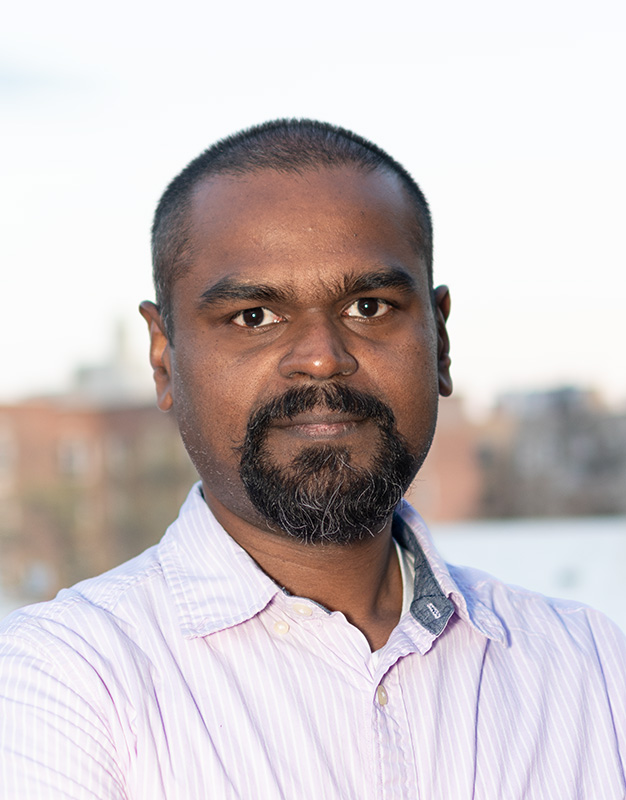From New Delhi to New York
Academy Fellow Nitin Verma is taking a closer look at deepfakes and the impact they can have on public opinion.
Published April 23, 2024
By Nick Fetty
Digital Content Manager
Nitin Verma’s interest in STEM can be traced back to his childhood growing up in New Delhi, India.

Verma, a member of the inaugural cohort for the Artificial Intelligence (AI) and Society Fellowship, a collaboration between The New York Academy of Sciences and Arizona State University’s School for the Future of Innovation in Society, remembers being fascinated by physics and biology as a child. When he and his brother would play with toys like kites and spinning tops, he would always think about the science behind why the kite stays in the sky or why the top continues to spin.
Later, he developed an interest in radio and was mesmerized by the ability to pick up radio stations from far away on the shortwave band of the household radio. In the early 1990s, he remembers television programs like Turning Point and Brahmānd (Hindi: ब्रह्मांड, literally translated to “the Universe”) further inspired him.
“These two programs shaped my interest in science, and then through a pretty rigorous school system in India, I got a good grasp of the core concepts of the major sciences—physics, chemistry, biology—and mathematics by the time I graduated high school,” said Verma. “Even though I am an information scientist today, I remain absolutely enraptured by the night sky, physics, telecommunication, biology, and astronomy.”
Forging His Path in STEM
Verma went on to pursue a bachelor’s in electronic science at the University of Delhi where he continued to pursue his interest in radio communications while developing technical knowledge of electronic circuits, semiconductors and amplifiers. After graduating, he spent nearly a decade working as an embedded software programmer, though he found himself somewhat unfulfilled by his work.
“In industry, I felt extremely disconnected with my inner desire to pursue research on important questions in STEM and social science,” he said.
This lack of fulfillment led him to the University of Texas at Austin where he pursued his MS and PhD in information studies. Much like his interest in radio communications, he was also deeply fascinated by photography and optics, which inspired his dissertation research.
This research examined the impact that deepfake technology can have on public trust of photographic and video content. He wanted to learn how people came to trust visual evidence in the first place and what is at stake with the arrival of deepfake technology. He found that perceived, or actual, familiarity with content creators and depicted environments, contexts, prior beliefs, and prior perceptual experiences guide public trust in the material deemed trustworthy.
“My main thesis is that deepfake technology could be exploited to break our trust in visual media, and thus render the broader public vulnerable to misinformation and propaganda,” Verma said.
A New York State of Mind

After completing his PhD, he applied for and was admitted into the AI and Society Fellowship. The fellowship has enabled him to further his understanding of AI through opportunities such as the weekly lecture series, collaborations with researchers at New York University, presentations he has given around the city, and by working on projects with Academy colleagues such as Marjorie Xie and Akuadasuo Ezenyilimba.
Additionally, he is part of the Academy’s Scientist-in-Residence program, in which he teaches STEM concepts to students at a Brooklyn middle school.
“I have loved the opportunity to interact regularly with the research community in the New York area,” he said, adding that living in the city feels like a “mini earth” because of the diverse people and culture.
In the city he has found inspiration for some of his non-work hobbies such as playing guitar and composing music. The city provides countless opportunities for him to hone his photography skills, and he’s often exploring New York with his Nikon DSLR and a couple of lenses in tow.
Deepfakes and Politics
In much of his recent work, he’s examined the societal dimensions (culture, politics, language) that he says are crucial when developing AI technologies that effectively serve the public, echoing the Academy’s mission of “science for the public good.” With a polarizing presidential election on the horizon, Verma has expressed concerns about bad actors utilizing deepfakes and other manipulated content to sway public opinion.
“It is going to be very challenging, given how photorealistic visual deepfakes can get, and how authentic-sounding audio deepfakes have gotten lately,” Verma cautioned.
He encourages people to refrain from reacting to and sharing information they encounter on social media, even if the posts bear the signature of a credible news outlet. Basic vetting, such as visiting the actual webpage to ensure it is indeed the correct webpage of the purported news organization, and checking the timestamp of a post, can serve as a good first line of defense against disinformation, according to Verma. Particularly when viewing material that may reinforce one’s beliefs, Verma challenges them to ask themselves: “What do I not know after watching this content?”
While Verma has concerns about “the potential for intentional abuse and unintentional catastrophes that might result from an overzealous deployment of AI in society,” he feels that AI can serve the public good if properly practiced and regulated.
“I think AI holds the promise of attaining what—in my opinion—has been the ultimate pursuit behind building machines and the raison d’être of computer science: to enable humans to automate daily tasks that come in the way of living a happy and meaningful life,” Verma said. “Present day AI promises to accelerate scientific discovery including drug development, and it is enabling access to natural language programming tools that will lead to an explosive democratization of programming skills.”
